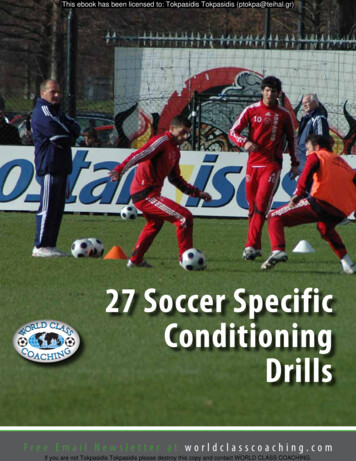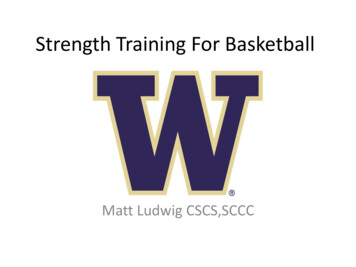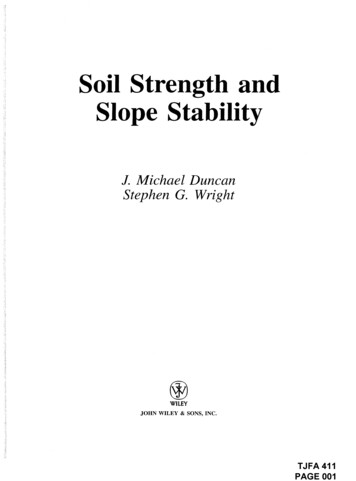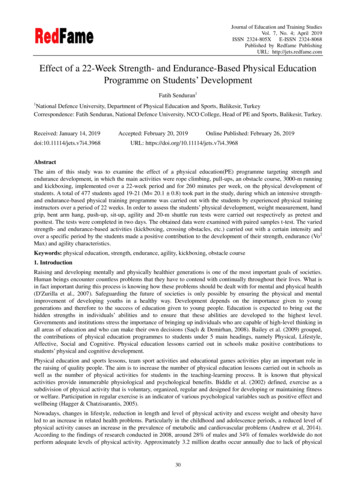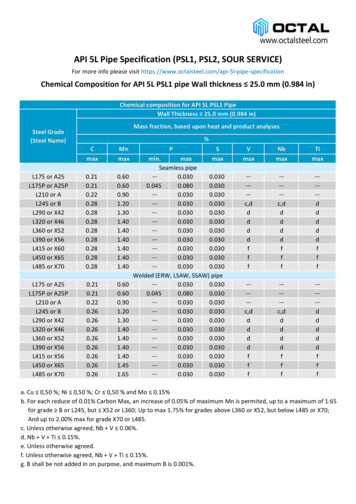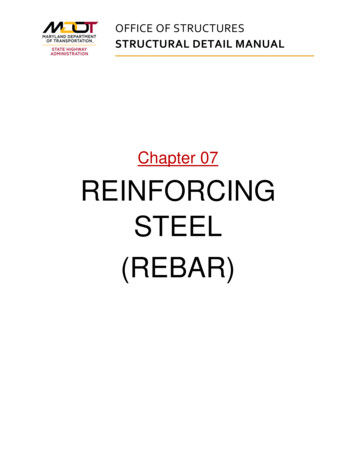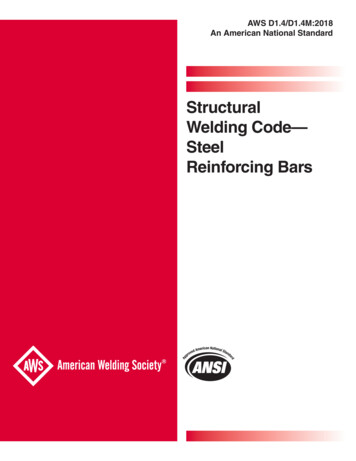
Transcription
Advances in High-StrengthReinforcing Bar Research in the U.S.Wassim M. GhannoumUniversity of Texas at San AntonioMarch 26th, 2017
Roadblocks for Implementing HSRB1- Material Issues Stress-strain behaviorFatigue behaviorProduction Repeatability2- Structural Issues StiffnessStrain compatibilityBar demandsDetailing
Material Issues
Stress Strain BehaviorGrade 100 MMFXGrade 100 Micro-alloyingGrade 100 QuenchingGrade 60 ASTM A706Current HSRB produced have verydifferent stress-strain relations
Stress Strain BehaviorMMFXMicro-alloyingQuenchingGrade 60Fracture elongation?Yield plateau?
Stress Strain BehaviorMMFXQuenchingMicro-alloyingGrade 60Yield plateau?
Stress Strain BehaviorGrade 60MMFXMicro-alloyingQuenchingTensile-to-Yield Strength Ratio?
Other IssuesWhat about cyclic fatigue?What properties should themills target?
StructuralIssues
Overview of Structural Concerns Higher strain at yieldo larger crackso larger deflectionso strain compatibilityo effectiveness as shear reinforcement Higher strengtho larger tensile forces increase in bond demands increased forces in hooks and headso larger compressive forces increased bar buckling susceptibility given the same lateral bracing Less ductile barso less ductility for seismic members Tensile-to-yield strength (T/Y) ratioo plasticity spreado strain concentration at crackso higher strains can lead to premature fracture
Cycle of InactionEngineers do notspecify HSRBDesign Standardsdo not allow HSRBMills do notproduce HSRBResearch cannotbe performed onHSRB Industry needs guidance from engineers and researcherabout which properties to achieve in HSRB
Targeted Material andStructural Testing
Material Testing ProgramLow-Cycle FatigueGhannoum,W.M., Slavin, C.M., "Low-Cycle Fatigue Performance of High-Strength Steel ReinforcingBars," ACI Materials Journal,V. 113, No. 6, pp. 803-14, 2016.Slavin, C.M., Ghannoum,W.M., "Defining Structurally Acceptable Properties of High-Strength Steel Barsthrough Material and Column Testing, PART I: MATERIAL TESTING REPORT," (05-14), CharlesPankow Foundation, pp. 135, August 2015.
Experimental ProgramCompare low-cycle fatigue behavior of HSRB and grade 60 bars Grades 60; A-70680; A-706100; “Ductile” Clear-Spans Bar Sizes #5 - Transverse#8 - Longitudinal#11 - Longitudinal Loading Protocols:2 per bar size Manufacturing Techniques Microalloying withVanadiumQuenching andTempering4db5db6db 2% and 4%, -1% 2% and 4%, 0%
Typical Test#8 - 6db - 2%Ghannoum Vision System
Summary of FindingsGrade 100 HSRB1. Overall grade 100 bars showed 90% of cycles to failurethan grade 60 bars2. Large variability in performance of grade 1001.2.3.Worse performance for larger barsVariable performance at low clear spansSignificant differences between manufacturing processes
Results of Cyclic Tests – #8 at 2%
Summary of FindingsGrade 80 HSRB1. Large variability in performance of grade 80 bars1.2.3.2.Some samples performed much better than grade 60Others much worse ( 50% of cycles to failure of grade 60)Specifically A706 bars performed much worseFew tests on grade 80 bars in this first study
Column Testing ProgramSeries I: HSRB in Shear and ConfinementThree columns under high shear and axial stressesResults published in ACI Structural Journal May-June 2016Series 2: Plasticity Spread and Strain DemandsFour columns under low shear axial stressesTesting completed – Report published
Series 1Material Properties
Series 1Global ResultsCS60 and CS80GOOD PREFORMANCE Almost identical behavior for CS60 and CS80 Both specimens sustained shear and axial failures at large drifts andremained stable up to a drift ratio of 5.5%
Series 1Global ResultsGr 60Pushed after lowering axial load.Test Stopped 9.5%Gr 80Test Stopped -8.4%
Series 1Global ResultsCS100Bond failure at a drift ratio of 3%Deficiency in ACI 318 anchorage provisions / Ballot in progressCS 100Test Stopped 11.5%
Series 1Bar DemandsLongitudinal barsCS80 larger 65% larger than CS60CS100 strain 100% larger than CS60Same trends in transverse bars
Low-Cycle Fatigue Demand to Capacity HSRB may need better low-cycle fatigue performance than grade 60 bars
Series 2Overview Maximize strain demands in the bars Investigate three main types of HSRB being produced in USGrade 100T/Y 1.27(H)Grade 100T/Y 1.16(L)Grade 100T/Y 1.27(MMFX)Grade 60T/Y 1.45(H)CH100CL100CM100CH60
Series 2 Moderate axial load:o 15% of gross capacity Low shear stresses:o 4.0 𝑓𝑐′ Concrete compressive strength:o 5 ksi Same longitudinal reinforcement ratio andbar arrangement Hoop spacing variedDesign
Series 2Reinforcing Steel Properties#6 longitudinal bars in all 17.6
Series 2Test Results Similar behavior – bar fracture failure mode All specimens completed at least one full cycle to 5.5% drift ratio, beforesignificant bar buckling or bar fracture.
Series 2Failure ModeCH100CL100CM100CH60
Series 2Strain DemandsMean tension strain in longitudinal bars at critical section (normalized by section effective depth d) Complex behavior Directly comparable tests CL100 and CH100 indicate influence of T/Y ratio A1035 bars behave differently
Series 2Conclusions Overall similar and good seismic behavior for all four columnsregardless of steel type and grade Strain demands in longitudinal bar related to Axial loadBar strengthBar T/Y ratioShear stressBut what is an acceptable fatigue performance for HSRB? Follow up project is investigating this furtherComplementary BEAM Project at UC Berkeley
Performance Characterization of Beamswith High-Strength ReinforcementProject TeamDuy Vu To, Nick Hardisty, Jack MoehleBerkeleyUNIVERSITY OF CALIFORNIAAdvisory CommitteeDominic Kelley, Ron Klemencic, Andy Taylor, Loring WyllieSponsors and Contributors
Test Setup
ResultsBeam 1 – Grade 100 T/Y 1.18Beam 2 – Grade 100 T/Y 1.30Beam 3 – Grade 60 A706Beam 4 – Grade 100 A1035
Acceptable Elongations and Low-Cycle FatiguePerformance for High-Strength Reinforcing Bars2016 to 2018 timeline
Acceptable Performance for HSRBTasks1. Quantify low-cycle fatigue performance of HSRB in production inthe U.S. Associated experiments working with some mills to improve their barperformanceDevelop model for predicting bar fracture in concrete membersduring seismic motions2. Columns ,beams, wall, coupling beams3.Quantify differences in probability of collapse of seismicallydesigned buildings due to reinforcement differences (incollaboration with G. Deierlein at Stanford)4.Recommend design and ASTM bar specification adjustments tocommittee consensus probabilities of collapse
Objective and Scope8060Lateral Force (kips)40200-20-40G60 T/Y 1.46G100 T/Y 1.18-60-80-6-4-202468DriftReinforcing Bar Test - Low-cyclic capacityof G60 vs. G100 (Slavin et al. 2015)Concrete Column Test - Componentbehavior with G60 vs. G100 (To et al. 2016)Influence from high-strength reinforcingsteel: Reduced initial stiffness (less steel area, same fyAs) Damage Concentration (lower T/Y ratio) Premature fracture (lower fracture resistance)Acceptable Safety?Improve RebarORAdjust Design CriteriaKuanshi Zhong & Greg Deierlein; Stanford University
Broader Ongoing ResearchWhile steel bar production and ASTM specifications are beingfinalized
Ongoing and Future ResearchCharles Pankow Foundation commissioned study"Roadmap for the use of high-strength reinforcement in reinforced concretedesign," Applied Technology Council Project 115 Over 26 million of research needed to get Grades 80 and 100into ACI 318 standard over the next decade Bar BendsGravity BeamsShear WallsAnchorage and BondCoupling Beams
Performance of HSRBBendsObjectiveQuantify residual capacities of bends andrecommend bend diameters for HSRBZhao, S.D., Ghannoum, W.M., "Setting Bar-Bending Requirements for High-Strength Steel Bars,"(01-15), Charles Pankow Foundation, pp. 92, July 2016.
Test MatrixTest variables for bend/re-bend tests: Bar Size, ManufacturingProcess, Grade, Bend Diameter, and Strain Aging1.2.3.4.Manufacturer 1 (M1): Micro Alloyed SteelManufacturer 2 (M2): Patented Microstructure MMFXManufacturer 3 (M3): Combination of Quench and Tempering and MicroAlloyingManufacturer 4 (M4): Combination of Quench and Tempering and MicroAlloying
Grade 60Grade 60 Grade 100 Grade 80Grade 80ASTM A706ASTM A615Option 1: 95% confidence of achieving YSPOBar SizeβACIβRecom3 to 5 Transverse3 to 5 Longitudinal6 to 8113 to 5 Transverse3 to 5 Longitudinal6 to 8113 to 5 Transverse3 to 5 Longitudinal6 to 89 to 113 to 5 Transverse3 to 5 Longitudinal6 to 89 to 113 to 5 Transverse3 to 5 Longitudinal6 to 89 to 114.06.06.08.04.06.06.08.0Not SpecifiedNot SpecifiedNot SpecifiedNot 6.06.08.06.06.08.09.05.06.06.08.05.06.06.08.0* these bend ratios result in higher than 5% probabilities of failing the yield stress objective,which is deemed acceptable for A615 ties
Grade 60Grade 60 Grade 100 Grade 80Grade 80ASTM A706ASTM A615Option 2: HSRB match Gr60 bend performanceBar SizeβACIβRecom3 to 5 Transverse3 to 5 Longitudinal6 to 8113 to 5 Transverse3 to 5 Longitudinal6 to 8113 to 5 Transverse3 to 5 Longitudinal6 to 89 to 113 to 5 Transverse3 to 5 Longitudinal6 to 89 to 113 to 5 Transverse3 to 5 Longitudinal6 to 89 to 114.06.06.08.04.06.06.08.0Not SpecifiedNot SpecifiedNot SpecifiedNot 06.08.05.06.08.09.04.06.06.08.05.06.06.08.0
Next Steps Cold weather bend performance? New project investigating bend performance at coldtemperatures (Sponsored by CRSI) Will revisit bend diameters for HSRB when results are out( end of 2017)
GRAVITY BEAMSMonotonic Beam TestsJohn Nicholas HardistyJack Moehle
Two test seriesSeries 2Series 1
Series 1: et 0.034
Series 1 – Load-Deflection80Load [k]60402000241GBH60 (1.66)68Deflection [in.]1GBL100 (1.18)10121GBH100 (1.26)14
Series 2 – Explore behavior near lower limits of etGrade 60Grade 100ey 0.002?2ey
Series 2 – High rfy
Failure
GRAVITY BEAMSREINFORCEMENT LIMITS FORSTRUCTURAL CONCRETE ELEMENTSWITH HIGH-STRENGTH STEELAISHWARYA Y. PURANAMSANTIAGO PUJOL
Maximum Reinforcement in BeamsWhat εt is needed in beams with high-strength steel?Tests of Continuous Beams with conventional and high-strength longitudinal reinforcementf’c 4500 psify 60 ksi, 100 ksi, 120 ksiDesigned so that net tensile strain is 0.005Series 1 Cross-Section: 18 in. x 30 in.at concrete strain of 0.003Series 2 Cross-Section: 14 in. x 20 in.
Tests completed so farSupportMid-span11 #8 Gr. 60 BarsSeries 1:BEAM 6030 in.18 in.8 #8 Gr. 60 Bars5 #8 Gr. 120 BarsSeries 1:BEAM 1203 #8 Gr.120 Bars
Applied Load, w (kip/ft)Test results so far161514131211109876543210Beam 60Beam 1200.00.51.01.52.0Rotation at Mid-span (%)2.53.0
WALLSHigh-Strength Steel Bars in RC Walls:Influence of Mechanical Properties of Steelon Deformation CapacityPrincipal InvestigatorsAndrés LepageRémy LequesneGraduate StudentsMohammad S. HuqAlex Weber-KaminShahedreen Ameen
Project ParticipantsCharles Pankow Foundation (RGA #06-14)The University of Kansas (Dept. of CEAE)Concrete Reinforcing Steel Institute (CRSI, M. Mota)CMC - Arizona: J. SelzerNUCOR - Seattle: E. NissenHarris Rebar - Kansas City: P. Fosnough, M. King, J. MeddingsAmerican Concrete InstituteAdvisory PanelDave Fields, MKA, SeattleRamón Gilsanz, GMS, New YorkDominic Kelly, SGH, BostonConrad Paulson, WJE, Los Angeles
Grade 100 Steel Bars (No. 6 Bars)140T4120T3T2Stress, ksi100T180Grade 100 (690) [Wall T4]Grade 100 (690) [Wall T3]60Grade 100 (690) [Wall T2]Grade 60 (420) [Wall T1]0.2% Offset40Peak 60.18Id.fy (ksi)T/Yf 'c (ksi)esu 51.388.68.5
Wall SpecimensTestsCompletedT1 and T3(October 2015)T3T1T2 and T4(June 2016)
Wall Cross SectionT1T2, T3, T4
Shear vs. Drift RatioBarfractureT1 – 60 ksiT3 – 100 ksiId.fy (ksi)T/Yf 'c (ksi)esu 51.388.68.5
Shear vs. Drift Ratio#4#6BarfractureT1 – 60 ksiT2 – 100 ksiId.fy (ksi)T/Yf 'c (ksi)esu 51.388.68.5
Shear vs. Drift RatioBarfracture#6T1 – 60 ksiT4 – 100 ksiId.fy (ksi)T/Yf 'c (ksi)esu 51.388.68.5
Test ResultsT1 – 60 ksiT2 – 100 ksi2% Drift Ratio
Special attributes of steel bars in T2(1) No. 4 bars in T2 had the lowest T/Y ratio of all bars.Measured T/Y was 1.14(2) No. 4 bars in T2 had the lowest esu.Measured esu was 5.6%(3) Sharp edges in deformation pattern of longitudinal bars.(Reported poor performance in low-cycle fatigue tests)(4) Strain gauges on No. 4 bars at the wall-base interface.(Potentially creating a weak plane)
CONCLUSIONS
Conclusions Overall good behavior of concrete members with HSRB Some concerning tests that highlight Detailing issuesImportance of selecting acceptable bar propertiesImportance of reliable bar productionSeems like HSRB will be the future Similar concerns were overcome when moving from Gr40 to Gr60
The End
Zhao, S.D., Ghannoum, W.M., "Setting Bar-Bending Requirements for High-Strength Steel Bars," (01-15), Charles Pankow Foundation, pp. 92, July 2016. Objective Quantify residual capacities of bends and recommend bend diameters for HSRB. Test Matrix Test variables for bend/re-bend tests: Bar Size, Manufacturing
